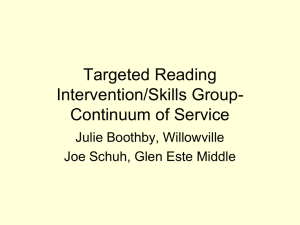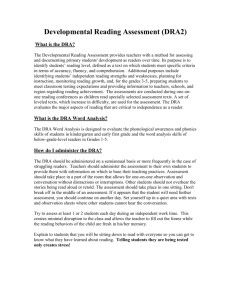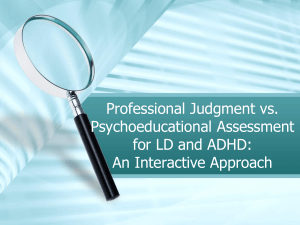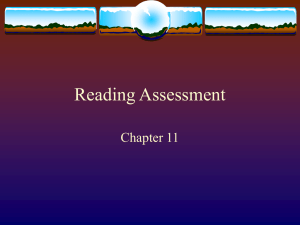Running Records Training Final
advertisement
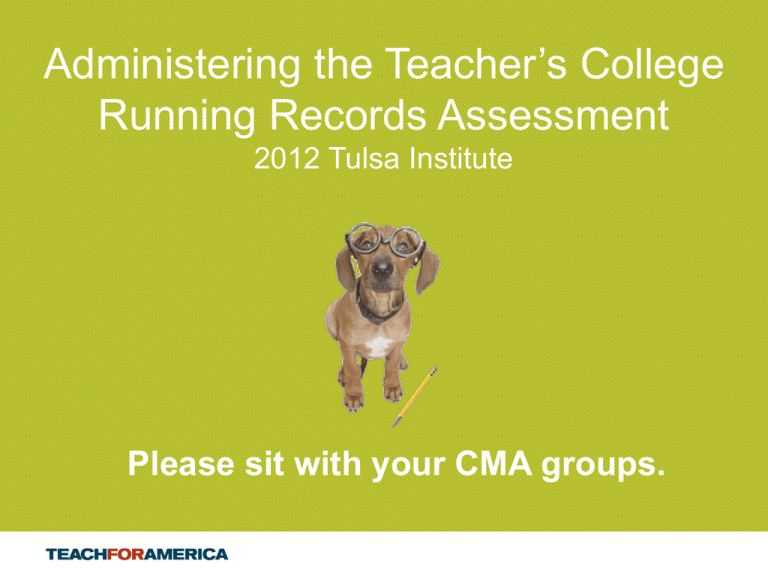
Administering the Teacher’s College Running Records Assessment 2012 Tulsa Institute Please sit with your CMA groups. 1 Your Presenters • Julie Baker, Houston ’09, Kansas City MTLD julie.baker@teachforamerica.org LS at Hamilton and & Robertson • Angelica Leveroni, Rio Grande Valley 2007 angelica.leveroni@gmail.com LS at Hale, McLain, & Rogers 2 Agenda 1 What is a reading level? Why does it matter? 2 Why do we use Running Records? 3 4 Steps to Administering a TC Running Record CM Practice Tough Facts. Of children who live below the poverty line for at least a year during their K-12 education and are not reading proficiently by third grade, more than a quarter never finish high school. The rate is highest for low-income AfricanAmerican and Hispanic students, at 31% and 33% respectively. On average, African-American and Hispanic 12th graders in the US read at the same level as Caucasian 8th graders. Roughly 35% of low-income high school graduates are not ready to succeed in an introductory level college writing course. Tonight’s Objectives Identify the components of a student’s reading level and explain the significance of this information to targeted, goaldriven reading instruction and long-range growth. Identify the purpose and components of a Running Records reading assessment and be prepared to administer and score an assessment for their own students. What is a Reading Level? Grade level approximation Decoding + comprehension Some examples: Flesch Kincaid scores (Microsoft Word) DRA levels Lexiles Fountas & Pinnell Why do we test for a reading level? Select developmentally appropriate texts. “Frustration level” texts: Kids make frequent errors; teacher should read these aloud. “Instructional level” texts: Kids have some foundational knowledge but require direct instruction. “Independent level” texts: Kids read & understand on their own. Set clear, meaningful goals & benchmarks. Flexible (ability) grouping From where does the approximation come? For kids: “Trial and error” For texts: Complexity of… Vocabulary Sentence structure Sentence variety Decoding Fluency Comprehension The Facts: Running Records Purpose: determine student’s ability to read and comprehend text at a given level. Outcome: Fountas & Pinnel score (A-Z) Process: Find a ceiling. : Fluency + comprehension Limitations: Subjectivity This is not an exact science. …but it will be invaluable to your work. 5 Steps to Administering Running Records 1. 2. 3. 4. 5. Find a starting point. Gather materials. Assess oral reading. Assess comprehension. Calculate final score to determine whether text is at independent level. 11 Step 1: Find a Starting Point • The San Diego Quick (SDQ) • Start at pre-primer • Check off words that are correct • Record errors • Stop the students when he/she misses 3 words in a grade level • Choose the lowest letter from that grade level to start your Running Records 12 Snapshot: San Diego Quick 13 San Diego Quick: Ms. Bisso & Scarlett • Where does she make three mistakes? • Where would we start her Running Records? 14 Step 2: Gather Materials • Start with the lowest letter for the grade level you determined on the San Diego Quick • Scarlett 3rd grade • Use your Reading Level Correlation Chart 15 Step 2: Gather Materials •For Student • Student text Level N •For Teacher • Teacher text and scoring forms for Level N • Teacher text and scoring forms for level below and above • Sample responses for comprehension questions 16 Step 3: Assess Oral Reading Fluency •Student reads first 100 words aloud •Teacher times student and notes miscues on scoring form 17 Miscues that count as errors Miscues that don’t count as errors Substitutions Self-corrections sitting at the small back (black) table Mispronunciations Repetition Severely severly Omissions Short Pauses a boy can hatch a plan Insertions Pete flew ^right^ in through the door Reversals So dumbfounded and startled Teacher prompts 18 Step 3: Scoring Oral Reading Fluency • Record accuracy rate 100 - # of miscue errors 100 • Determine fluency score Rubric: 4 categories 93% accuracy rate 2 on the Fluency Rubric 19 Step 4: Assess Comprehension • Student finishes reading the rest of the text silently • Student gives an oral retelling of the passage • Can prompt if necessary, but make note of this • Use Retelling Rubric to rate • Student answers 4 comprehension questions orally • 2 literal questions • 2 inferential questions 2 on Retelling Rubric 2/4 comprehension questions correct 20 Step 5: Final Score Sheet Note – This score sheet assesses for your student’s independent level. 21 CM Practice • Handouts you will need for this portion - Blank San Diego Quick - Running Record N - Sample Student Response N 22 Practice: San Diego Quick • Based on the San Diego Quick results, what running record level should we start assessing her at? Grade 3 Level N 23 Practice: Oral Reading Fluency • What was her accuracy rate? • How would you rate her on the fluency scale? 98% accuracy 4 on Fluency Rubric 24 Practice: Comprehension Assessment • How would you rate her on the Retelling Rubric?. • How many comprehension questions would you give her credit for? 4 on Retelling Rubric 3 out of 4 questions 25 Practice: Final Score & Next Steps • Calculate final score. • Next steps? Independent at Level N Continue testing until she is no longer independent 26 When kids start behind, they stay behind. 27 Contact Info • Julie Baker, julie.baker@teachforamerica.org LS at Hamilton & Robertson • Angelica Leveroni, angelica.leveroni@gmail.com LS at Hale, McLain, & Rogers http://readingandwritingproject.com/resources/assess ments/reading-assessments.html OR Google “Teacher’s College Reading Assessments” 28


